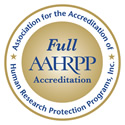Our Mission
The Human Research Protection (HRP) Education & Outreach (E&O) program is a unified cross campus initiative to provide education and outreach to all who are involved in research involving human subjects. Our mission is to equip researchers with the knowledge and tools needed to navigate the regulatory landscape of human subjects research.
Through proactive engagement, the program aims to support researchers and promote ethical practices that enhance understanding of human subjects protections across the university community.
The HRP Education & Outreach program goals are to:
- Inform the research community about the latest developments in human subjects protection, including news, guidance, and regulatory updates.
- Educate researchers, IRB members, and IRB staff through tailored outreach and ongoing learning opportunities.
- Support investigators through compliance reviews, self-monitoring tools, and personalized assistance to promote high-quality, ethically sound research.
By offering these resources, we seek to reduce compliance burdens and foster a culture of collaboration and integrity in research involving human participants.
What We Offer
The Education & Outreach program offers a variety of resources designed to support researchers, IRB members, and IRB staff. We welcome your feedback and ideas as we grow our offerings.
IRB Office Hours
Connect one-on-one. Meet with HRP staff to ask questions, seek guidance, or discuss specific concerns:
Workshops & Trainings
Custom Education or Training
Request a session tailored to your department, unit or class. Content is designed to meet your research specific needs. To request a training or education session, please click the link below and complete the form, including a brief description of the topic or area you would like the session to cover.

Electronic Submissions Trainings
UConn InfoEd training: For questions related to the use of InfoEd, please contact the UConn IRB at irb@uconn.edu.
UConn Health iRIS training: For individual or group training session on iRIS, please contact the UConn Health IRB at irb@uchc.edu.
UConn Storrs Trainings Offered On-Demand
FDA-Regulated Research Training Sessions –To support research teams conducting studies subject to FDA regulations under 21 CFR Part 312 (Investigational New Drug Application) or 21 CFR Part 812 (Investigational Device Exemptions), the HRPP offers completion of a two-part training process:
· Pre-Study Implementation Session: Designed to prepare teams before initiating FDA-regulated research.
· Post-Implementation Assessment: Conducted after the enrollment of the first five participants to evaluate and support ongoing compliance.
HRPP staff will provide an overview of relevant guidance and institutional policies, with a focus on adhering to Good Clinical Practice (GCP). Participants will also learn about the essential components of a Regulatory Binder and its role in maintaining compliance throughout the research process. To schedule these sessions, please complete our Training and Education Request Form.
UConn Health Trainings Offered On-Demand
New Investigator Training –This education session is offered to researchers who are new to UConn Health or are new to submitting to the IRB for the first time. This session is offered on a recurring schedule, every six weeks. Please visit our Bookings page and select “First Time PI Training (UConn Health)” to book a spot in one of these upcoming trainings.
FDA Regulated Research – Sponsor-Investigator Compliance Review – UConn Health researchers who will fill the dual role of Sponsor and Investigator when conducting studies subject to FDA regulations under 21 CFR Part 312 (Investigational New Drug Application) or 21 CFR Part 812 (Investigational Device Exemptions) are required to complete a compliance review prior to submitting their study for IRB review. This session is conducted to ensure that the Sponsor-Investigator is aware of and prepared to meet the dual responsibilities of Sponsor and of Investigator under the FDA regulatory requirements. Please contact Rebecca Burke at burke@uchc.edu to schedule a session.
Upcoming sessions
Coming in 2026! Stay tuned for dates and registration links!
Common Compliance Pitfalls: Join us in the New Year to review the most common errors found during human subjects research compliance monitoring in the last year. Learn what to watch out for and practical strategies to avoid these common pitfalls! Date: TBA
Review Categories: Is my study exempt, expedited or full board? Or is it even human subjects research? In this presentation, we will go over the categories of review and what each type of IRB submission entails. Date: TBA
Conflict of Interest: Have questions about how to address potential conflicts of interest in the context of human subjects research? We have the answers! We will be discussing all the requirements related to IRB submissions and conflicts of interest. Date: TBA
Research Compliance Monitoring
Human subjects research at UConn and UConn Health is monitored by the HRP Education & Outreach program. The goal of the monitoring program is to assess compliance of human subjects research with federal, state, local law, and UConn policies, identifying areas for improvement, and providing recommendations and support based on best practices, current policies and the principles set forth in the Belmont Report. More information about the monitoring program can be found in our policies and standard operating procedures.
All active studies are subject to such reviews, including exempt research or studies where a reliance agreement is in place with another institution.
Studies may be randomly selected for a compliance review or chosen for other reasons as described in the applicable policies and procedures. Categories of compliance reviews include routine, informed consent, for-cause, IRB-directed, and investigator-initiated.
A detailed report summarizing the review findings, required actions, and recommendations will be sent to the researcher. Additionally, findings from the review may be shared with individuals responsible for research oversight to reinforce compliance with policies and regulatory requirements. Findings from these reviews help inform and shape future educational offerings.
Related Policies & Procedures:
Contact Us
We are here to support your research. Reach out to ask questions, request a consultation, or share feedback.
Email: hrp-education@uconn.edu
Team Contacts:
- Joan Levine, MPH, CIP – Team Lead
- Rebecca Burke, MS
- Ellen Ciesielski

